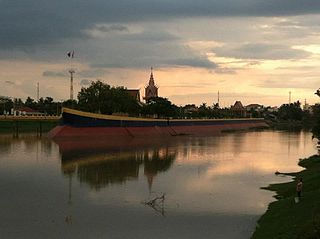| Suoy | |
|---|---|
| Su'ung | |
| Native to | Cambodia |
| Region | Kampong Speu |
Native speakers | 860 (2007) [1] |
Austroasiatic
| |
| Language codes | |
| ISO 639-3 | syo |
| Glottolog | suoy1242 [2] |
Suoy is an endangered Pearic language of Cambodia spoken by a decreasing number of people, mainly older adults. It is spoken in Kampong Speu Province and Pursat Province, in the Phumi Krang Trachak area (Ethnologue).

Cambodia, officially the Kingdom of Cambodia, is a country located in the southern portion of the Indochina peninsula in Southeast Asia. It is 181,035 square kilometres in area, bordered by Thailand to the northwest, Laos to the northeast, Vietnam to the east and the Gulf of Thailand to the southwest. The sovereign state of Cambodia has a population of over 16 million. The official religion is Theravada Buddhism, practised by approximately 95 percent of the population. The country's minority groups include Vietnamese, Chinese, Chams and 30 hill tribes. The capital and largest city is Phnom Penh, the political, economic and cultural centre of Cambodia. The kingdom is an elective constitutional monarchy with a monarch, currently Norodom Sihamoni, chosen by the Royal Throne Council as head of state. The head of government is the Prime Minister, currently Hun Sen, the longest serving non-royal leader in Southeast Asia, ruling Cambodia since 1985. In 802 AD, Jayavarman II declared himself king, uniting the warring Khmer princes of Chenla under the name "Kambuja". This marked the beginning of the Khmer Empire, which flourished for over 600 years, allowing successive kings to control and exert influence over much of Southeast Asia and accumulate immense power and wealth. The Indianised kingdom facilitated the spread of first Hinduism and then Buddhism to much of Southeast Asia and undertook many religious infrastructural projects throughout the region, including the construction of more than 1,000 temples and monuments in Angkor alone. Angkor Wat is the most famous of these structures and is designated as a World Heritage Site. After the fall of Angkor to Ayutthaya in the 15th century, a reduced and weakened Cambodia was then ruled as a vassal state by its neighbours. In 1863, Cambodia became a protectorate of France, which doubled the size of the country by reclaiming the north and west from Thailand.

Kampong Speu is a province (khaet) of Cambodia. It borders the provinces of Pursat and Kompong Chhnang to the north, Kandal to the east, Takeo to the southeast, Kampot to the south and Koh Kong to the west. Its capital is Chbarmorn town.

Pursat is a province (khaet) of Cambodia. It is located in the western part of the country and borders clockwise from the north with Battambang Province, the Tonlé Sap, Kampong Chhnang Province, Kampong Speu Province, Koh Kong Province, and Thailand. It is located between the Tonle Sap and the northern end of the Cardamom Mountains. The Pursat River bisects the province, running from the Cardamoms in the west to the Tonle Sap in the east.






